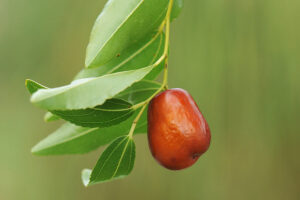The jujube is about the size of an olive or small date and has the texture and crisp, sprightly flavor of an apple.
You can eat the jujube fresh out of hand or you can enjoy it dried—a favorite in China—or preserved in syrup—a favorite also in China and in Korea. The jujube can also be eaten cooked, made into compotes and jams, or into paste. Jujube paste is used to make jujube candy; yes, that “Jujube”, the one you nibble at the movies.
The jujube fruit has a greenish-yellow to yellowish-red color with smooth skin. As the jujube matures its reddish skin darkens to maroon and then to purplish black and begins to wrinkle like a date. That is why the jujube (pronounced joo-joob) is also known as the red date or Chinese date.
Serving jujubes
The skin of the jujube can be thick and tough but is edible. The jujube has a greenish-to-whitish flesh that is not very juicy. The jujube is a drupe, a stone fruit. The stone is hard.
The jujube be is often eaten out of hand as a snack and is sometimes served with tea.
When you bite into a fresh jujube it will be crunchy, yet a bit floury textured, and the taste will vary from sweet-tart to sweet. At its sweetest, the jujube can taste prune-like.
The jujube can be treated like a date in the kitchen. Cook the jujube just like a date for use in desserts, soups, stuffing, and stews. Use jujubes in compotes and jams or make them into a paste
In Persian cuisine, the dried jujube is known as annab.
If you buy dried jujubes, soak them in water before you use them. Chinese cooks use jujubes in both sweet and savory dishes.

How to choose jujubes
Select jujubes that are fresh and unblemished fruit. The jujube should be the size of an olive or small date and should be heavy for its size. A mature jujube will be wrinkled.
How to store jujubes
Jujubes will keep in the refrigerator indefinitely. Place them in an airtight container.
Jujube flavor partners
Jujubes have a flavor affinity for almonds, brown sugar, chocolate, coconut, cream cheese, honey, orange, pistachios, and walnuts.
Jujube nutrition
The jujube is an excellent source of vitamin C and a good source of potassium.
About jujube
The jujube grows on a tree that reaches from 25 and 35 feet (7.6-10.6 m) tall. It has shiny, dark green leaves that are almost waxlike.
The jujube grows in mild to temperate dry areas of both hemispheres. It can tolerate a wide range of temperatures and rainfall but requires hot summers to fruit. Jujube trees grow in China, India, Africa, Mediterranean countries, and the United States. The jujube was first grown in Texas in the mid-1800s.
The jujube is native from southeastern Europe to China and has been in cultivation for more than 4,000 years. There are believed to be as many as 400 cultivars of the jujube.
The classic Greek tale The Odyssey by Homer features a plant called “lotus” which turned lotus eaters lethargic and forgetful. That lotus is believed to be the jujube, although there is nothing in the jujube’s natural state that would make it drug-like.
The botanical name of the jujube is Ziziphus jujube.
Related articles:
Planning the Home Fruit Garden
Garden Planning Books at Amazon:
- Vegetable Garden Almanac & Planner
- Kitchen Garden Grower’s Guide Vegetable Encyclopedia
- Vegetable Garden Grower’s Guide
- Tomato Grower’s Answer Book
More kitchen tips:
Bring your harvest to the table. Kitchen prep tips and easy recipes for the vegetables you grow. Click below for vegetable prep and recipes you can use now.
- Almonds
- Apples
- Apricot
- Aprium
- Artichoke
- Arugula
- Asparagus
- Avocado
- Bamboo Shoots
- Banana
- Basil
- Beans, Dried
- Beans. Long
- Beans, Shell
- Beans, Snap
- Beets
- Bitter Melon
- Blackberry
- Bok Choy
- Broccoli
- Broccoli Raab
- Brussels Sprouts
- Cabbage
- Cardoon
- Carrots
- Cauliflower
- Celeriac
- Celery
- Chard
- Chayote Squash
- Cherimoya
- Cherries
- Chestnut
- Chickpea
- Chinese Cabbage
- Chives
- Cilantro
- Citron
- Clementine
- Collards
- Coriander
- Corn, Sweet
- Corn, Baby
- Corn Salad, Mache
- Cranberry
- Cress
- Cucumber
- Daikon
- Dandelion
- Dill
- Eggplant
- Endive, Belgian
- Endive and Escarole
- Fava Beans
- Fig
- Florence Fennel
- Garlic
- Ginger
- Grapefruit
- Grapes
- Guava
- Horseradish
- Jerusalem Artichoke
- Jicama
- Jujube
- Kale
- Kiwifruit
- Kohlrabi
- Kumquat
- Leeks
- Lemongrass
- Lemons
- Lettuce
- Lime
- Mache (Corn Salad)
- Mandarin Orange
- Mango
- Maple Syrup
- Marjoram
- Melons
- Michihili
- Mint
- Mizuna
- Mushrooms
- Mushrooms, Cremini
- Mustard Greens
- Napa Cabbage
- Nectarine
- Okra
- Olives
- Olive oil
- Onions
- Oranges
- Oregano
- Parsley
- Parsley Root
- Parsnips
- Passion Fruit
- Pawpaw
- Peaches
- Pears
- Peas, Garden Snap
- Peas, Snow
- Pei Tsai
- Peppers, Chili
- Peppers, Sweet
- Persimmon
- Pineapple
- Pineapple Guava
- Plantain
- Plums
- Pluots
- Pomegranate
- Potatoes
- Prickly Pear
- Pumpkin
- Quince
- Radicchio
- Radishes
- Raspberries
- Rosemary
- Rhubarb
- Rutabaga
- Sage
- Salsify
- Sauerkraut
- Savory
- Shallots
- Sorrel
- Spinach
- Squash, Summer
- Squash, Winter
- Strawberries
- Sunchokes
- Sunflower
- Sweet Potato
- Swiss Chard
- Tangerine
- Taro
- Tarragon
- Thyme
- Tomatillo
- Tomato
- Turnip
- Turnip Greens
- Yams















